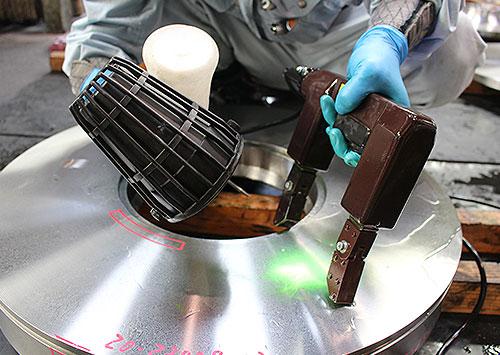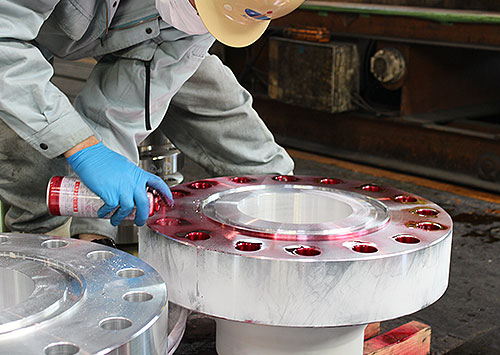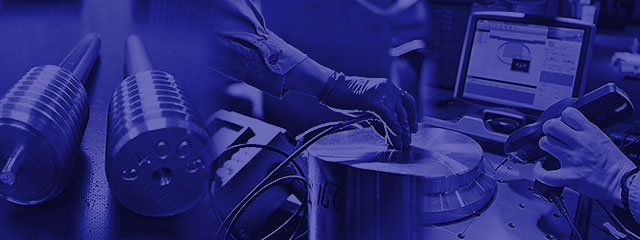Quality control
Forged products are often required to have high specifications and may require various tests and inspections. We can perform various tests during the manufacturing process and after product completion. We have established a strict test and inspection system in order to reliably supply the products required by customers, such as material tests, non-destructive tests, component analysis, and dimensional tests.
Inspection type
| Inspection type |
|---|
| Tensile test (Room/High/low temp.) |
| Impact test (Room/ High/ low temp.) |
| Hardness test |
| Ultrasonic test |
| Magnetic particle test |
| Liquid penetration test |
| Component analysis test |
| Grain size test |
| Appearance and dimension inspection |
* Some inspection items are outsourced.
Inspection equipment
| Inspection equipment | |
|---|---|
| Universal tester | 1 |
| Charpy impact tester | 1 |
| Brinell hardness testers | 1 |
| Ultrasonic testing equipment | 5 |
| Magnetic inspection equipment | 2 |
| Portable Brinell hardness tester | 1 |
| Portable hardness tester | 2 |
| Equotip hardness tester | 1 |
| Positive Material Identification tester | 1 |
| Radiation thermometer | 2 |
| 3D measuring machine | 1 |
Non-destructive inspection
Non-destructive inspection is essential for ensuring the quality of forged products. We have many non-destructive testing qualifications and carry out inspections. We also maintain an in-house SNT-TC-1A certification system. Therefore, it is possible to support not only JIS standards but also overseas standards such as ASME standards and ASTM standards.
Inspection type
①Ultrasonic test (UT)

The ultrasonic test is a test method that uses the property that ultrasonic waves propagate in metal and are reflected at the boundary surface of different objects. Since it is possible to measure the position and size by receiving the echo reflected by scratches, it is widely used when detecting internal defects in forged steel products. There are mainly two types of flaw detection methods, straight beam technique and angle beam technique, suitable for the product shape is adopted.
Straight beam technique
Straight beam technique is a method of applying ultrasonic waves perpendicularly to the test surface, and is often used when inspecting forged steel products. When ultrasonic waves enter, only the echo on the bottom surface appears on the flaw detector monitor in the normal area, but if there is a flaw, the echo of the flaw appears before the echo on the bottom surface to detect the internal flaw.
Angle beam technique
Angle beam technique is a method in which ultrasonic waves are obliquely incident on the flaw detection surface. It is mainly used for inspection of welded parts and pipe materials that are difficult to detect by the vertical flaw detection method or thin forged steel roducts. When ultrasonic waves are incident, an echo appears only when there is a reflection source such as a scratch.
Feature
Since it has a high ability to detect flaws and cracks inside the product and it is possible to identify the position and size of flaws from the appearance of echoes. It is an inspection method suitable for detecting internal defects in forged steel products.
②Magnetic particle test (MT)

The magnetic particle flaw detection test is an inspection method in which magnetic flux is applied to the test piece to detect cracks and scratches on the surface layer of the product. If magnetic flux is applied to the test piece during inspection and there are scratches on the surface of the test piece, leakage flux will occur at the scratches. When the magnetic powder is applied to that part, the magnetic powder is adsorbed and a magnetic powder pattern is formed, so that the scratches can be visually confirmed.
Feature
Not only scratches that are open but cannot be visually recognized, as well as non-open scratches directly below the surface can be detected. By using fluorescent magnetic powder, it is possible to detect minute flaws. However, since it is applied only to ferromagnetic materials, the applicable materials are limited.
③Liquid penetration test (PT)

The liquid penetrant inspection test is an inspection method that detects surface cracks, scratches, blowholes, etc. by using an inspection liquid with good red and fluorescent penetrability. The test liquid is applied to the surface of the object to be inspected, and after a certain period of time, the excess test liquid on the surface is removed and the phenomenon liquid is applied. At that time, if there are cracks or scratches on the surface, the test liquid that has penetrated into the opening will ooze out, so opening scratches can be detected.
Feature
It is widely used for non-hygroscopic materials regardless of whether it is magnetic, non-magnetic, metal or non-metal, and it is excellent for detecting scratches on the surface opening.
Qualified person
| Code | Inspection type | Level3 | Level2 |
|---|---|---|---|
| JSNDI | Ultrasonic test | 8 | |
| JSNDI | Magnetic particle test | 4 | |
| JSNDI | Liquid penetration test | 5 | |
| SNT-TC-1A | Ultrasonic test | 3 | 1 |
| SNT-TC-1A | Magnetic particle test | 3 | 1 |
| SNT-TC-1A | Liquid penetration test | 3 | 1 |
| SNT-TC-1A | Visual testing | 3 | 4 |
Since we maintain the SNT-TC-1A certification system in-house, we can flexibly support overseas standards.
We also accept requests for non-destructive inspection only.



